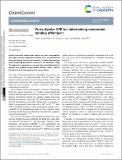Pulse dipolar EPR for determining nanomolar binding affinities
Date
14/08/2022Grant ID
204821/Z/16/Z
RPG-2018-397
BB/R013780/1
BB/T017740/1
Metadata
Show full item recordAbstract
Protein interaction studies often require very low concentrations and highly sensitive biophysical methods. Here, we demonstrate that pulse dipolar electron paramagnetic resonance spectroscopy allows measuring dissociation constants in the nanomolar range. This approach is appealing for concentration-limited biomolecular systems and medium-to-high-affinity binding studies, demonstrated here at 50 nanomolar protein concentration.
Citation
Ackermann , K , Wort , J & Bode , B E 2022 , ' Pulse dipolar EPR for determining nanomolar binding affinities ' , Chemical Communications , vol. 58 , no. 63 , pp. 8790-8793 . https://doi.org/10.1039/D2CC02360A
Publication
Chemical Communications
Status
Peer reviewed
ISSN
1359-7345Type
Journal article
Description
This research was funded, in whole or in part, by the Wellcome Trust (204821/Z/16/Z). BEB and KA acknowledge support by the Leverhulme Trust (RPG-2018–397). JLW acknowledges support by the BBSRC DTP Eastbio. BEB acknowledges equipment funding by BBSRC (BB/R013780/1 and BB/T017740/1).Collections
Items in the St Andrews Research Repository are protected by copyright, with all rights reserved, unless otherwise indicated.

